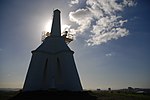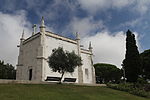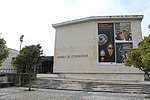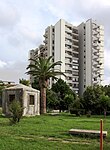Monsanto Tower
Buildings and structures in Oeiras, PortugalCommercial buildings completed in 2001Portuguese building and structure stubsSkyscrapers in Portugal

The Monsanto Tower (Portuguese: Torre de Monsanto) is a 394-foot (120 m) skyscraper in Oeiras, a town and municipality to the west of Lisbon which is part of the Portuguese capital's urban agglomeration. Finished in 2001, the 17-floor building is the second tallest in Portugal, and the tallest in Lisbon. Lisbon-based architectural firm Sua Kay Architects designed the 21,000-square-metre (230,000 sq ft) office building.
Excerpt from the Wikipedia article Monsanto Tower (License: CC BY-SA 3.0, Authors, Images).Monsanto Tower
Circular Regional Interior de Lisboa (CRIL), Algés, Linda-a-Velha e Cruz Quebrada-Dafundo
Geographical coordinates (GPS) Address External links Nearby Places Show on map
Geographical coordinates (GPS)
| Latitude | Longitude |
|---|---|
| N 38.7158 ° | E -9.2219 ° |
Address
Torre de Monsanto
Circular Regional Interior de Lisboa (CRIL)
2795-122 Algés, Linda-a-Velha e Cruz Quebrada-Dafundo
Portugal
Open on Google Maps







